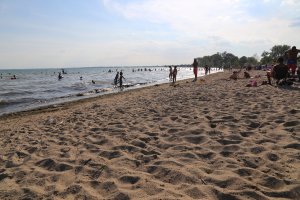Water Footprints
Author: Victoria Taylor Sluder, HCMA District Interpretive Services Supervisor
We all have a water footprint.
In the same way that environmental groups talk about “carbon footprints” and greenhouse gases, the activities and choices of people leave their marks on another of our most precious natural resources, water. And like the air around us, water is a shared resource- so no one’s footprints are distinctly separate from anyone else’s.
Sometimes we can look back at tracks in the sand to see our solitary trail of prints and know we are the source. Oftentimes there are so many we cannot distinctly tell who left the marks. They become mingled together across the landscape to leave a mosaic of impressions. This is how we can think of the effect people have on water with point source and nonpoint source pollution.

The Water Encyclopedia defines a pollutant as a substance that enters the environment and elevates the “natural” background level of that substance. In many cases, the natural system may not have any of the substance present until human activities add it to the environment. Pollution originating from a single, identifiable source, such as a discharge pipe from a factory or sewage plant, is called point-source pollution. Pollution that does not originate from a single source is called nonpoint source pollution.
The effect of our water footprints are marks that become clear when they combine in our watersheds. Water gathers as it travels to form ever larger water features on the land. Drops become trickles, ponds and streams; creeks become rivers and lakes. This draining of water from its original source across the land is a watershed. In areas without visible pooling or flow, water seeps down into spaces underground. These aquifers also eventually feed the rest of the area’s exposed freshwater. Even in areas coated in asphalt and pavement, the water of gutters moves to storm drains and other channels with outlets to natural bodies of water.
Water does not drain alone. As it travels, contaminants come along for the journey. Waste matter and chemicals mix in from all points of contact along the way. By the end, a major watershed is a drainage basin of all the waters- and what washed along with them- from many hundreds of miles around.
Do you know your watershed?
It is a fact that nowhere in Michigan is more than six miles from a lake or stream, or more than 85 miles from a Great Lake. The water footprint of the Huron-Clinton Metroparks are the watersheds of the Huron, Clinton and Rouge Rivers. And as all these flow to it, ultimately the Lake Erie Watershed. If you live in the five counties containing a Metropark these are your watersheds, too.
No matter the drainage destination, wherever the water flows it still does not stay there. It returns to us. To supply our need for drinking water and other uses like cooking and bathing, it is brought back to our homes and businesses. Depending on where you live, this may be from the river which swells with road runoff each springtime through pipes laid during the Great Depression, or up out of your well from the same ground shared by your local dairy farm, golf course and car repair shop.
And you are your watershed.
This means the choices made by everyone that lives and works in your watershed- including you- determine the quality of water in your next glass or shower. It also means the actions you take and the voice you use to make change determine whether that water is allowed to be clean and a resource for all.
- Do industries, refineries, and pharmaceutical manufacturers contaminate the watershed sediment with cancer-causing chemicals, oils, and heavy metals?
- Do “forever chemicals” like PFAS make their way into your well and drinking water, fish and farm crops?
- Does aging infrastructure leave you vulnerable to high water bills, shut offs and the burden of bottled water when you can’t trust your taps?
- Does your property and vehicle send dangerous pollutants down the neighborhood drain?
- Do your Metroparks support water recreation as well as habitat for wildlife?
- Do you have an influence on water policies at all levels of government?
You decide. It’s your water footprint.
Inspired to get involved but don’t know where to start? Here are a few suggestions:
- Learn more about your watershed from the Michigan Department of Environment, Great Lakes, and Energy (EGLE): mi.gov/hydrology.
- Attend a Huron-Clinton Metroparks Board of Commissioners meeting https://www.metroparks.com/meeting-schedule/
- Volunteer with We the People of Detroit, a community coalition dedicated to mobilizing the citizens of Detroit and beyond to improve their quality of life. https://www.wethepeopleofdetroit.com/get-involved-old
- Support The Alliance for the Great Lakes, a nonpartisan nonprofit working across the region to protect fresh, clean, and natural waters of the Great Lakes. https://greatlakes.org/get-involved/
